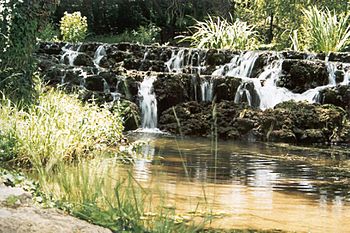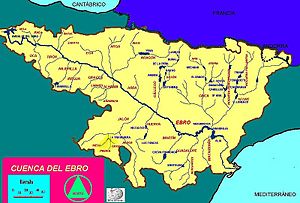Piedra (Spain) facts for kids
Quick facts for kids Piedra |
|
|---|---|

The Piedra flowing through the Monasterio de Piedra area
|
|

The watershed of the Piedra within the Ebro basin.
|
|
| Country | Spain |
| Region | Castile-La Mancha, Aragón |
| District | province of Guadalajara, province of Zaragoza |
| City | Campillo de Dueñas, Cimballa, Nuévalos, Carenas, Castejón de las Armas |
| Physical characteristics | |
| Main source | Campillo de Dueñas province of Guadalajara, Castile-La Mancha, Spain 1,195 m (3,921 ft) 40°49′59″N 1°39′18″W / 40.833°N 1.655°W |
| River mouth | Castejón de las Armas province of Zaragoza, Aragón, Spain 590 m (1,940 ft) 41°19′08″N 1°48′36″W / 41.319°N 1.810°W |
| Length | 76 km (47 mi) |
| Basin features | |
| Progression | Jalón→ Ebro→ Mediterranean Sea |
| Tributaries |
|
| River system | Ebro |
The Piedra River (which means 'Stone River' in Spanish) flows through the Iberian System in Spain. It's a smaller river that eventually joins the Jalón River. The Piedra gets its special name because its water has a lot of calcium carbonate. This mineral builds up on plants and rocks near the river's start, making them look like stone!
River Journey
The Piedra River begins its journey near Campillo de Dueñas. This area is in the province of Guadalajara, which is part of Castile-La Mancha. The river's flow changes a lot throughout the year. It can be quite low during the dry summer months. However, it gets much more water during the spring and autumn when there is heavy rainfall.
Many people think the river starts in Cimballa, in the province of Zaragoza. But it actually begins near Campillo de Dueñas. The very top part of the river often dries up in summer. But below Campillo, springs add more water, so the river always has water from that point onwards.
Waterfalls and Pools
From Cimballa, the Piedra River flows into the beautiful water gardens of the Monasterio de Piedra. Here, the water's high calcium content has created amazing waterfalls and rocky pools. This area is a type of Karst topography, which means the landscape has been shaped by dissolving rocks.
The Monasterio de Piedra is a very popular place for visitors. It feels like a green oasis in the middle of a dry, rocky mountain area. It's a great spot to explore nature's artwork!
River's End
After leaving the Monasterio, the river flows down to the La Tranquera Dam near Nuévalos. This dam creates a large reservoir. Other rivers, like the Mesa, Ortiz, and Munebraga, also flow into this reservoir. They can be thought of as smaller rivers that feed into the Piedra.
From La Tranquera, the Piedra River continues past Carenas. Finally, it joins the larger Jalón River near Castejón de las Armas and Ateca.
River Life
The Piedra River used to be home to the European freshwater crayfish. This type of crayfish is an endangered species. Sadly, most of them have disappeared from the river and its smaller streams. This happened because another type of crayfish, the North American signal crayfish (Pacifastacus leniusculus), was brought into the area. The signal crayfish outcompeted or harmed the native European crayfish.
In 1988, the government of Aragón created a special fish reserve at Monasterio. This reserve helps to raise fish. The goal is to provide fish to restock other rivers in Aragón. This helps to keep the fish populations healthy.
See also
 In Spanish: Río Piedra para niños
In Spanish: Río Piedra para niños

